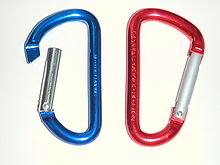JonBoatfever
Well-known member
I bought 3M maine aluminum restorer and polish, it says its safe for painted aluminum boats like mine but says not to be used on anodized aluminum. What is anodized aluminum?
thanks
thanks

https://en.wikipedia.org/wiki/Anodizing
These inexpensive decorative carabiners have an anodized aluminium surface that has been dyed and are made in many colors.
Aluminium alloys are anodized to increase corrosion resistance, to increase surface hardness, and to allow dyeing (coloring), improved lubrication, or improved adhesion. The anodic layer is non-conductive.[3]
When exposed to air at room temperature, or any other gas containing oxygen, pure aluminium self-passivates by forming a surface layer of amorphous aluminium oxide 2 to 3 nm thick,[4] which provides very effective protection against corrosion. Aluminium alloys typically form a thicker oxide layer, 5-15 nm thick, but tend to be more susceptible to corrosion. Aluminium alloy parts are anodized to greatly increase the thickness of this layer for corrosion resistance. The corrosion resistance of aluminium alloys is significantly decreased by certain alloying elements or impurities: copper, iron, and silicon,[5] so 2000, 4000, and 6000-series alloys tend to be most susceptible.
Although anodizing produces a very regular and uniform coating, microscopic fissures in the coating can lead to corrosion. Further, the coating is susceptible to chemical dissolution in the presence of high and low pH chemistry, which results in stripping the coating and corrosion of the substrate. To combat this, various techniques have been developed either to reduce the number of fissures or to insert more chemically stable compounds into the oxide, or both. For instance, sulfuric anodized articles are normally sealed, either through hydro-thermal sealing or precipitating sealing, to reduce porosity and interstitial pathways that allow for corrosive ion exchange between the surface and the substrate. Precipitating seals enhance chemical stability but are less effective in eliminating ion exchange pathways. Most recently, new techniques to partially convert the amorphous oxide coating into more stable micro-crystalline compounds have been developed that have shown significant improvement based on shorter bond lengths.
Some aluminium aircraft parts, architectural materials, and consumer products are anodized. Anodized aluminium can be found on mp3 players, flashlights, cookware, cameras, sporting goods, window frames, roofs, in electrolytic capacitors, and on many other products both for corrosion resistance and the ability to retain dye. Although anodizing only has moderate wear resistance, the deeper pores can better retain a lubricating film than a smooth surface would.
Anodized coatings have a much lower thermal conductivity and coefficient of linear expansion than aluminium. As a result, the coating will crack from thermal stress if exposed to temperatures above 80 °C. The coating can crack, but it will not peel.[6] The melting point of aluminium oxide is 2050 °C, much higher than pure aluminium's 658 °C.[6] (This can make welding more difficult.) In typical commercial aluminium anodization processes, the aluminium oxide is grown down into the surface and out from the surface by equal amounts. So anodizing will increase the part dimensions on each surface by half of the oxide thickness. For example a coating that is (2 μm) thick, will increase the part dimensions by (1 μm) per surface. If the part is anodized on all sides, then all linear dimensions will increase by the oxide thickness. Anodized aluminium surfaces are harder than aluminium but have low to moderate wear resistance, although this can be improved with thickness and sealing.
JonBoatfever said:also how do I know if my boat has anodized aluminum
You'd need a pretty big dip tank. Definitely doable, probably wouldn't be cheap. They used to anodize fairly large parts at a place I used to work at, but nothing close to the size of a boatdyeguy1212 said:I wonder what itd cost to anodize a boat :LOL2:
It'd be a heck of a lot more durable than paint, thats for sure.
Enter your email address to join: